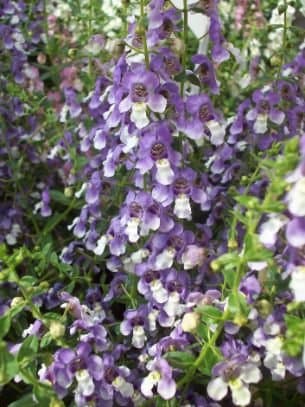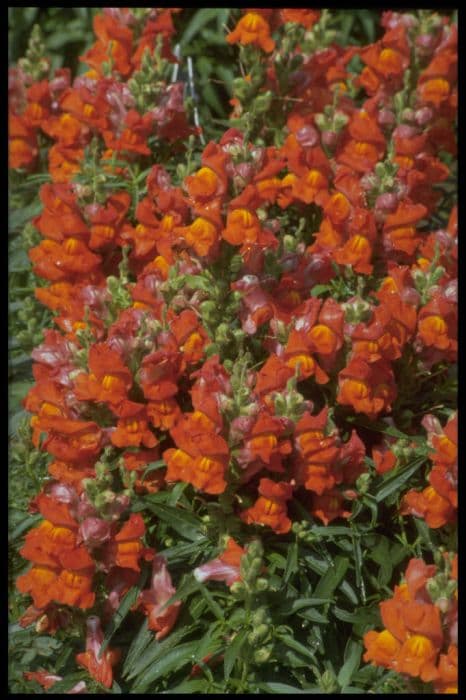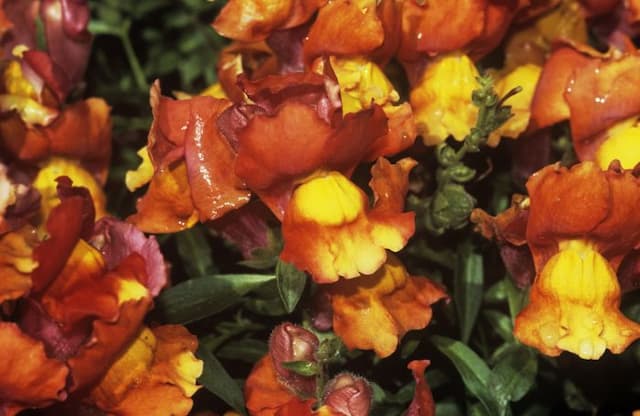New Zealand Hebe Hebe hulkeana

ABOUT
The Hebe hulkeana, more commonly known as the New Zealand hebe, is a visually appealing plant characterized by its attractive foliage and floral display. This plant typically features broad, lance-shaped leaves that have a glossy, deep green appearance. The leaves are arranged oppositely on the stems, creating a sense of order and symmetry. During the blooming season, the New Zealand hebe showcases a profusion of flowers that grow in dense, spike-like clusters. The blossoms are generally small and tubular, often seen in shades of blue or violet, though they can occasionally be white or pink. These flowers are particularly attractive to bees and butterflies, which are drawn to their nectar. Overall, the New Zealand hebe is noted for its lush and vibrant presence in the garden, adding both texture and color to the landscape.
About this plant
 Names
NamesFamily
Plantaginaceae
Synonyms
New Zealand Hebe, Hulke's Hebe
Common names
Hebe salicifolia var. hulkeana, Veronica hulkeana.
 Toxicity
ToxicityTo humans
There is no widely recognized common name for Hebe hulkeana that is universally accepted, as it is typically referred to by its botanical name. It is not well known for being toxic to humans. However, general information on the Hebe genus suggests that these plants are not typically considered poisonous. As a result, ingesting parts of Hebe hulkeana is not expected to cause significant toxic symptoms in humans. Nonetheless, any consumption of plants not intended for human consumption should be approached with caution and medical advice should be sought if ingestion occurs and adverse symptoms are experienced.
To pets
The plant Hebe hulkeana, commonly known by its botanical name, does not have a widely recognized toxicity profile in pets. There is limited information available on the poisoning symptoms in pets caused by this specific species. In general, Hebe species are not known for being severely toxic to pets. However, it is recommended to prevent pets from ingesting plants that are not specifically intended for animal consumption. If your pet does consume Hebe hulkeana and shows signs of distress, please consult a veterinarian. Symptoms that could potentially arise depend on various factors, including the amount ingested, but generally, there may be mild gastrointestinal upset.
 Characteristics
CharacteristicsLife cycle
Perennials
Foliage type
Evergreen
Color of leaves
Green
Flower color
Varies
Height
3 feet (0.9 meters)
Spread
3 feet (0.9 meters)
Plant type
Shrub
Hardiness zones
8
Native area
New Zealand
Benefits
 General Benefits
General Benefits- Aesthetic Appeal: Hebe hulkeana, commonly known as New Zealand Hebe, adds visual interest to gardens with its glossy green foliage and delicate flowers.
- Habitat for Wildlife: It provides nectar for bees, butterflies, and other pollinating insects, thus promoting biodiversity.
- Low Maintenance: New Zealand Hebe is known for being hardy and requiring minimal care once established, making it ideal for gardeners who prefer low-maintenance plants.
- Drought Tolerance: Once established, it has a good level of drought tolerance, reducing the need for regular watering.
- Versatility: It can be used in a variety of garden settings, including borders, rockeries, and as groundcover.
- Evergreen: As an evergreen shrub, it provides year-round color and structure in the garden.
- Wind Resistance: It's capable of withstanding windy conditions, which is particularly useful in coastal areas.
 Medical Properties
Medical PropertiesThis plant is not used for medical purposes.
 Air-purifying Qualities
Air-purifying QualitiesThis plant is not specifically known for air purifying qualities.
 Other Uses
Other Uses- Wildlife Garden Attraction: Hebe hulkeana is known to attract bees, butterflies, and other pollinators, making it a valuable plant for supporting biodiversity in a garden setting.
- Dye Production: The flowers and leaves of Hebe hulkeana may be used to produce natural dyes for textiles, though this is not a common practice.
- Erosion Control: Due to its dense foliage and robust growth habit, it can be planted on slopes or areas prone to erosion to help stabilize the soil.
- Garden Sculpting: The plant can be trimmed and shaped into various forms, which can contribute to its use in formal gardens for creating defined shapes and borders.
- Bonsai: With its small leaves and woody stems, Hebe hulkeana can be cultivated as a bonsai plant, offering an unconventional option for enthusiasts.
- Culinary Decoration: While not widely recognized for edible use, its flowers could potentially be used as decorative, non-toxic garnishes on food.
- Photographic Subject: It is sometimes planted and maintained by photographers who appreciate its aesthetic value as a subject for nature photography.
- Windbreak: Its thick foliage can serve to provide some protection against the wind, making it suitable for planting in exposed areas or coastal regions.
- Artistic Inspiration: Artists may draw inspiration from the distinctive features of Hebe hulkeana, such as its flower spikes, for paintings, illustrations, and design work.
- Theme Gardens: The plant can be used in thematic garden designs, such as a Victorian-era garden or a purple-themed garden, due to its historic charm and purple flowers, respectively.
Interesting Facts
 Feng Shui
Feng ShuiThe plant Hebe is not used in Feng Shui practice.
 Zodiac Sign Compitability
Zodiac Sign CompitabilityThe plant Hebe is not used in astrology practice.
 Plant Symbolism
Plant Symbolism- Youth: Hebe is the goddess of youth in Greek mythology, and plants named after her, such as the Hebe hulkeana, can symbolize eternal youth and freshness.
- Rejuvenation: The vibrant foliage and flowers of the Hebe hulkeana represent the renewal and rejuvenation of nature.
- Vitality: With its robust growth and healthy appearance, the Hebe hulkeana is often associated with vitality and vigorous life.
- New Beginnings: The plant's propensity for growth and its evergreen nature can symbolize new starts and fresh opportunities.
- Protection: In some cultures, evergreen plants like Hebe hulkeana are believed to offer protection and ward off negative energies.
 Water
WaterShrubby veronica, which is the most common common name for Hebe hulkeana, should be watered moderately, ensuring the soil is kept moist but not waterlogged. Generally, this means watering once every week with about 1 gallon of water, although this may need to be adjusted based on weather conditions and soil drainage. During hot, dry periods, watering frequency should be increased, while in cooler, wetter months, it can be decreased. Always check the top inch of soil for dryness before watering, as over-watering can lead to root rot.
 Light
LightShrubby veronica thrives in a location with full sun to partial shade. The ideal spot is one where it can receive at least six hours of sunlight per day, with some protection from harsh afternoon sun to prevent leaf scorching. A light-dappled area under a high canopy or eastern exposure where it receives morning light would be ideal for promoting healthy growth and flowering.
 Temperature
TemperatureShrubby veronica prefers temperate conditions and grows best when the temperature ranges between 50°F and 70°F. It can tolerate a minimum temperature down to about 30°F and can survive short periods of frost. However, temperatures exceeding 75°F for extended periods can stress the plant, and it should be protected from extreme heat.
 Pruning
PruningShrubby veronica benefits from pruning to maintain its shape, encourage bushiness, and remove any dead or damaged stems. Prune in late winter or early spring before new growth begins. It's best to cut back the plant by about one-third of its size, shaping it as desired. Additionally, after flowering, lightly trim the plant to remove spent flower spikes and encourage a second bloom.
 Cleaning
CleaningAs needed
 Soil
SoilNew Zealand Hebe prefers well-draining soil with a mixture of loam, peat, and sharp sand, ensuring good aeration and moisture retention. The best soil pH for this hebe is slightly acidic to neutral, ranging from pH 6.0 to 7.0.
 Repotting
RepottingNew Zealand Hebe should be repotted every 2 to 3 years to replenish soil nutrients and encourage healthy growth. Younger plants may benefit from more frequent repotting, while mature plants can be repotted less often.
 Humidity & Misting
Humidity & MistingNew Zealand Hebe thrives best in moderate humidity levels, typical of outdoor environments. This plant does not require high humidity; it is relatively tolerant of varying air moisture conditions.
 Suitable locations
Suitable locationsIndoor
Place New Zealand Hebe in bright, indirect light.
Outdoor
Plant in well-drained soil, full sun to partial shade.
Hardiness zone
7-10 USDA
 Life cycle
Life cycleHebe hulkeana, commonly known as New Zealand Lilac, begins its life cycle as a seed, typically dispersed by wind or animals. Upon finding a suitable environment, the seed germinates, developing into a seedling with basic root structures and leaves for photosynthesis. As the seedling matures, it becomes a vegetative plant, forming a well-established root system and fuller foliage. The plant then enters the reproductive stage, producing characteristic spikes of lilac or white flowers that are attractive to bees and other pollinators, leading to cross-pollination. After pollination, the flowers develop into small capsules containing seeds, which, when mature, are released to start a new life cycle. Lastly, New Zealand Lilac may eventually reach senescence, where growth slows and the plant may die, but not before potentially lasting several years and going through multiple flowering cycles.
 Propogation
PropogationPropogation time
Spring-Early Summer
Hebe hulkeana, commonly known as New Zealand hebe, is best propagated during the warmer months of late spring to early summer when the temperatures are conducive to root development. The most popular method of propagation for this plant is through semi-hardwood cuttings. To propagate, one should cut a 4 to 6-inch (10 to 15 cm) stem segment from a healthy plant, ensuring there are several leaf nodes present. The lower leaves should be removed, and the cut end dipped in rooting hormone to stimulate root growth. The cutting should then be placed in a well-draining soil mix, such as one containing peat and perlite. It is important to keep the soil consistently moist and provide a warm environment, but not in direct sunlight, until roots have established, which typically takes a few weeks. Covering the cutting with a plastic bag can help maintain humidity, but ensure that there is some ventilation to prevent mold growth. Once the cuttings have rooted, they can be transplanted into individual pots and gradually acclimated to outdoor conditions if desired.









